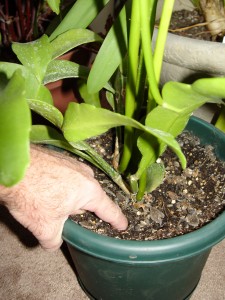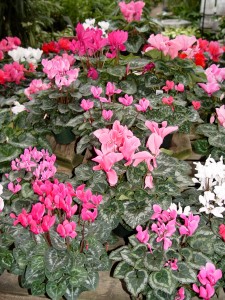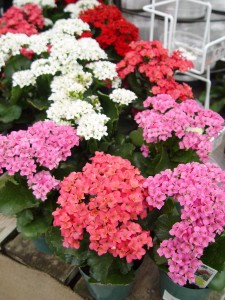Holiday Plant Survival Tips
January 5th, 2012
A lot of “brown-thumbers” end up with houseplants as gifts over the winter holidays and have no idea what to do with these festive adoptions.
If you’re going to kill them, too much water is the most likely way. The second most likely way is not enough water. So you might get the idea that watering is the main issue here.
To avoid too much water, poke holes in any foil-covered plants so the water can drain out. Set a saucer underneath to catch the drainage.
Or remove the foil and set the new plant – pot and all – into a larger decorative pot without holes to catch the drainage.
To gauge water needs, stick your finger in the soil or tip the pot to determine weight. Water when the soil’s dry or when the pot is noticeably lighter.
Add enough so the water drains out. Then empty the excess from the saucer.
Never mind fertilizing if you plan to toss the plant after it peters out. Otherwise, once a month is plenty for most houseplants.
Keep all houseplants away from cold drafts and heaters.
Some specifics:
* Poinsettias. Bright but indirect light (i.e. behind a sheer curtain). Start fertilizing in spring with a balanced plant food (20-20-20) and set outside in summer if you want to keep it.
* Amaryllis. Bright light, just not direct southern sun unless behind a sheer curtain. Turn pot every day or two to keep stems growing straight. Fertilize every 2 to 4 weeks with a balanced plant food and plant outside in May if you want to keep it.
* Christmas cactus.Bright but indirect light but also tolerates medium light. Let soil go dry before watering. Hates soggy soil. Fertilize monthly with a high-phosphorus plant food (15-30-15). Move outside in part shade in late May, then back in before frost.
* Paperwhites. Display in cool, bright spot. Turn every day or two to keep flower spikes growing straight. Keep water in the tray until they’re done blooming, then yank and toss. They’re not winter-hardy here.
* Cyclamen. Bright but indirect light, cool temps and humid air. Fertilize every 2 to 4 weeks with a half-strength, high-phosphorus plant food (i.e. 15-30-15) while the plant is in bloom. These will go dormant in late winter. Stop fertilizing and watering, plant outside in May, then dig up, pot and bring inside by late September if it lived.
* Orchids. Care varies depending on the type, but the most common moth orchids and dendrobiums prefer bright but indirect light. Fertilize monthly with a balanced liquid fertilizer. Repot in new bark mix every two years. Move outside in a shaded, protected area in summer.
* Norfolk Island pine. Medium to bright, indirect light. These are NOT hardy so don’t plant outside. They do appreciate being set outside — still potted — in part shade from late May to September.
* Kalanchoe.Bright but indirect light. Fertilize every two weeks with a half-strength, high-phosphorus plant food (15-30-15). Move outside in summer, back in by late September. Like poinsettias, kalanchoes need six to eight weeks of 14 hours of complete darkness each night in early fall to rebloom.
* Potted hyacinths, tulips. Bright but indirect light. Turn pot every every day or two to keep flower spikes growing straight. Fertilize every two weeks with a high-phosphorus plant food (15-30-15) if you plan to plant them outside in when the ground thaws in spring. These are hardy and may bloom the following spring.
* Potted hydrangeas. Bright light. Toss when done blooming or plant outside in spring if you want to take a crack at future outdoor flowers. Most greenhouse hydrangeas have flower buds that are not winter hardy. The plants usually survive, but they never flower.
* Miniature roses. Brightest light possible. Fertilize lightly with a balanced fertilizer in late spring. Plant out in late April or early may after gradually acclimating plant over a week or so.










